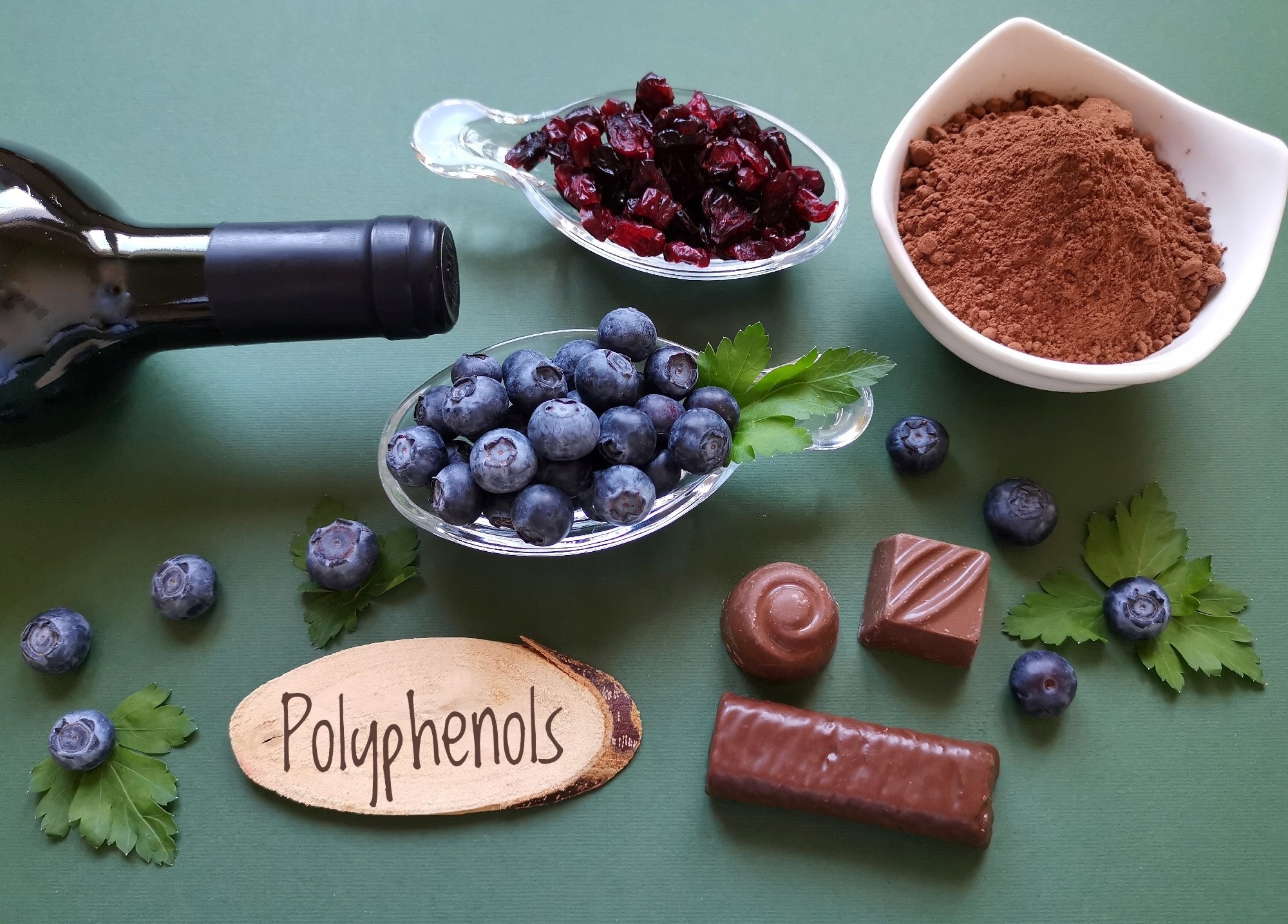Dietary phenols are phytochemicals comprising flavones, flavonols, flavanones, flavanonols, isoflavones, anthocyanidins, stilbenoids, lignans, tannins, and curcuminoids. These compounds, obtained from various natural sources, can be used to prevent and manage diseases in conjunction with the intestinal microbiome.
 Study: Dietary Phenolic Compounds: Their Health Benefits and Association with the Gut Microbiota. Image Credit: Danijela Maksimovic / Shutterstock.com
Study: Dietary Phenolic Compounds: Their Health Benefits and Association with the Gut Microbiota. Image Credit: Danijela Maksimovic / Shutterstock.com
Health benefits of phenolic compounds
Polyphenols may improve rheumatoid arthritis through mitogen-activated protein kinase (MAPK) inhibition. In addition, plant-derived polyphenols can reduce depression, inflammation, and oxidative stress.
Quercetin and epicatechin (EC) decrease atherosclerosis by augmenting nitric oxide (NO) activity and decreasing serological endothelin-1 levels. Quercetin, which can be obtained from red onion or grape powder, may reduce obesity and adipocyte macrophage-mediated insulin resistance by adipose tissue remodeling.
Cocoa/EC benefits cardiovascular patients by improving microcirculation, vasodilation and increasing NO levels. EC regulates the expression of proteins and genes in endothelial cells of the brain and, as a result, can be used to manage neurodegenerative diseases.
Extracts of green tea may benefit alcoholic fatty liver disease (AFLD) patients by decreasing serological triacylglyceride (TG) levels, reducing hepatic aminotransferase activity, preventing hepatic steatosis, lowering inflammation and oxidative stress, and modulating the intestinal microbiota. Among individuals with non-AFLD (NAFLD), epigallocatechin gallate (EGCG) has restored intestinal microbiome balance, prevented hepatic TG assimilation, and improved sirtuin gene activity.
Among colitis patients, EGCG lowers cyclooxygenase-2 (COX-2) levels, increases cell proliferation, facilitates epidermal growth factor (EGF)-mediated epithelial repair, reduces colonic damage, reduces malondialdehyde levels, and increases antioxidant enzymatic activity.
In Alzheimer’s disease, epigallocatechin (EGC) and epicatechin gallate (ECG) decrease amyloid-β accumulation, microglial inflammation, reactive oxygen species (ROS) production, and neurotoxicity. Cocoa extracts decrease amyloid-β oligomerization. In addition, EGCG protects microglia by nuclear factor kappa B (NF-κB) pathway inhibition and nuclear factor-like 2/heme oxygenase 1 (NRF-2/HO-1) pathway activation.
Cocoa flavanols help maintain normal endothelium-dependent vasodilation, thereby lowering the risk of coronary artery disease. Kaki tannins, obtained from astringent persimmon fruits, limit starch digestion, inhibit glucose uptake and transport, and reduce serological low-density lipoprotein (LDL) levels.
In addition to binding to the severe acute respiratory syndrome coronavirus 2 (SARS-CoV-2) spike protein, rutin, found in buckwheat and asparagus, regulates molecular pathways in tumor cells and can lower postprandial hyperglycemia and hypercholesterolemia. Soy proteins lower serological LDL cholesterol, C-reactive protein (CRP) levels, and urinary creatinine and deoxypyridinoline levels.
Sesamin, which is obtained from sesame, has demonstrated cardioprotective, neuroprotective, and anti-inflammatory effects by regulating the phosphatidylinositol 3-kinase (PI3K)/protein kinase B (AKT), extracellular signal-regulated kinase-1/2 (ERK-1/2), p38, interleukin-6 (IL-6), p53, tumor necrosis factor-alpha (TNF-α), and NF-κB signaling.
Resveratrol, obtained from red wine, lowers amyloid-β1-42 peptide-associated cytotoxicity, regulates α-synuclein expression, and inhibits platelet reactivity. Grape seed oil has wound-healing, anti-inflammatory, and hepatoprotective properties and can lower blood TG content.
Curcumin exerts anti-inflammatory and anti-cancer effects by inhibiting NF-κB, signal transducer and activator of transcription-3 (STAT-3), nuclear factor erythroid 2-related factor 2 (NRF-2), ROS, COX-2, and toll-like receptor-4 (TLR-4) pathways, and reversing epigenetic changes. Other compounds such as genistein, protocatechuic acid, ellagic acid, and chlorogenic acid also promote health and well-being.
Association between dietary polyphenols and the intestinal microbiota
Green tea extracts modulate the intestinal microbiome by activating Akkermansia muciniphila. Concord grape polyphenols aid in managing obesity by increasing Akkermansia muciniphila abundance and altering the Firmicutes to Bacteroidetes ratio.
Flavanoid-enriched cocoa powder elevates Bifidobacterium and Lactobacillus counts, thereby modulating intestinal-level immunity marker expression. Cocoa consumption enhances the gut-associated lymphoid tissue (GALT) function and alters the abundance of immunoglobulin A (IgA)-coating bacterial organisms in the intestinal microbiota.
Cocoa benefits diabetic individuals by restoring intestinal barrier integrity and reducing intestinal inflammation. Kaki tannings lower Mycobacterium avium complex (MAC) activity and decrease colonic inflammation by modulating immunological responses through altered intestinal microbiome composition.
Quercetin restores intestinal microbiome balance after antibiotic use. Chlorogenic acid improves intestinal barrier integrity and can reverse microbiome dysbiosis.
Coffee disrupts the intestinal flora by increasing the abundance of Bifidobacterium species and Clostridium coccoides-Eubacterium rectale group and can selectively enhance the growth of probiotic microbes.
Sesamin disrupts the intestinal flora by increasing the adhesive index of probiotics and upregulates β-cadherin and E-cadherin expression. Comparatively, sesamol exerts neuroprotective effects by mediating the gut microbe-short-chain fatty acid (SCFA)-brain axis.
Resveratrol activates metabolism by intestinal microbes, inhibits colonic CB2 messenger ribonucleic acid (mRNA) expression, and restores intestinal barrier function, thereby increasing insulin sensitivity. Curcumin can cause symptomatic improvements in Helicobacter pylori-infected gastritis, may prevent gallstone formation, and promote responses to cytarabine through modulation of the intestinal microbiota.
Conclusions
The review findings highlight the contribution of dietary phenolic compounds to health and their association with the intestinal microbiome. These findings could inform policy-making and strategy development to improve population health through dietary interventions.
Journal reference:
- Matsumura, Y., Kitabatake, M., Kayano, S.-i., & Ito, T. (2023). Dietary Phenolic Compounds: Their Health Benefits and Association with the Gut Microbiota. Antioxidants 12(880). doi:10.3390/antiox12040880